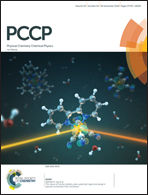Unusual dielectric response of 4-methyl-1,3-dioxolane derivatives†
Abstract
In this paper, we applied broadband dielectric spectroscopy (BDS) to investigate the molecular dynamics of three 4-methyl-1,3-dioxolane derivatives (MD) whose chemical structures differ in the length of non-polar alkyl side chains. We notice that small changes within their chemical structures have a pronounced impact on parameters characterizing the supercooled dynamics of the compounds selected for this study. Our detailed analysis of the dielectric response reveals that in the supercooled-liquid state besides the structural α-relaxation a sub-α Debye-like relaxation can be clearly distinguished. The observed two relaxation regimes mirror the structural complexity of the investigated MD derivatives. The amphiphilic nature of the investigated compounds and possible interactions between non-polar side chains can rationalize the observed behavior. To follow the molecular arrangement of MD derivatives at low temperatures, we also carried out Raman measurements. Additionally, we performed BDS measurements at elevated pressures which revealed that, as a result of compression, the sub-α contribution to the dielectric response disappeared. The paper concludes with a discussion of open questions about the possible molecular origin of the observed sub-α Debye-like process. These results provide fresh insight into the puzzling nature of the slow supramolecular relaxation modes in low-molecular glass forming liquids.



 Please wait while we load your content...
Please wait while we load your content...